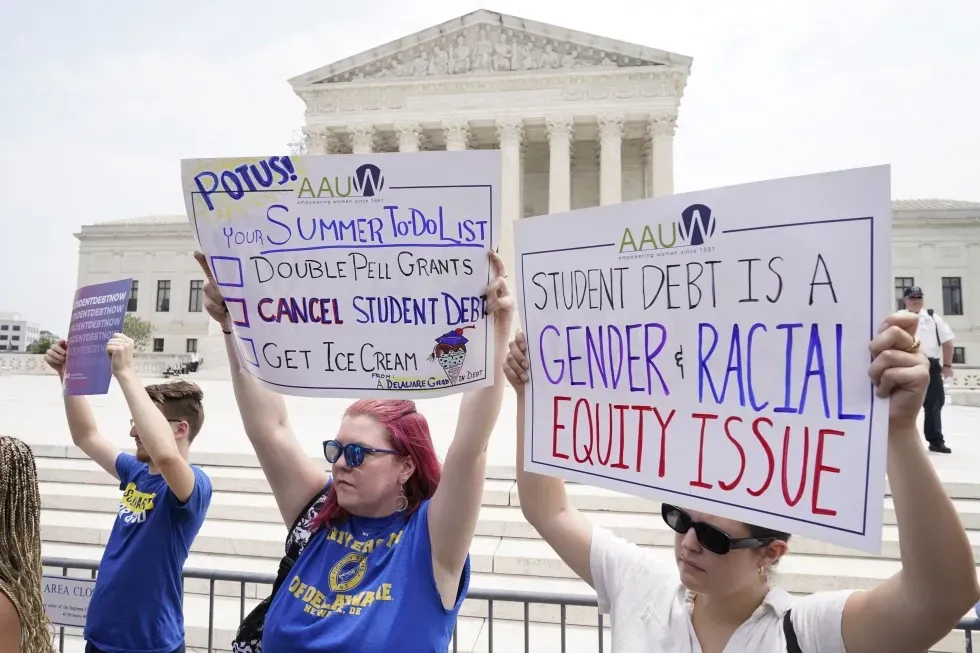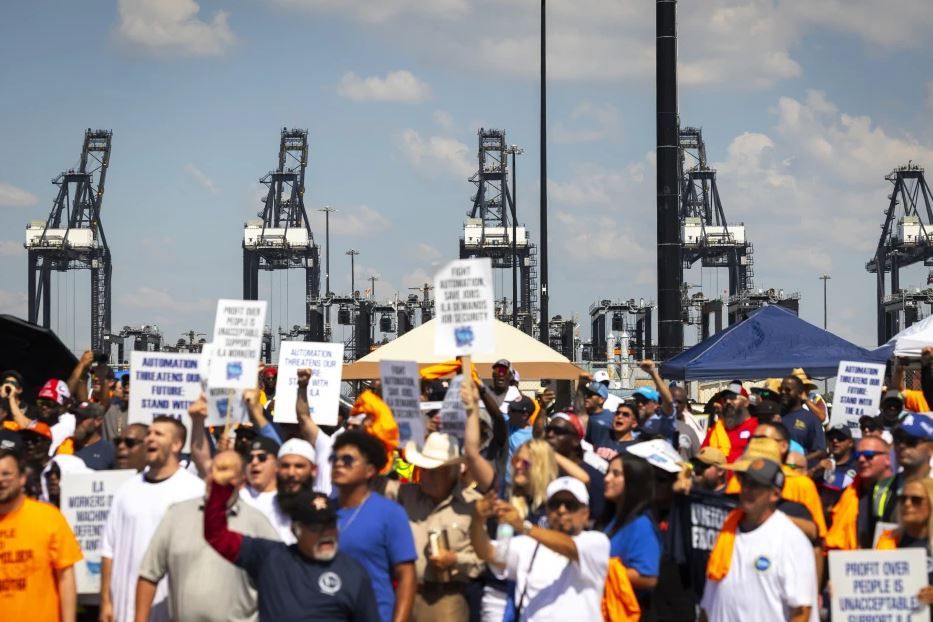Inflation Reduction Act May Have Little Impact on Inflation
- By 6122ee467d22433199917c7d
- •
- 19 Aug, 2022
With inflation raging near its highest level in four decades, Congress is poised to approve President Joe Biden’s signature Inflation Reduction Act.

WASHINGTON (AP) — With inflation raging near its highest level in four decades, Congress is poised to approve President Joe Biden's signature Inflation Reduction Act. Its title raises a tantalizing question: Will the measure actually tame the price spikes that have inflicted hardships on American households?
Economic analyses of the proposal suggest that the answer is likely no — not anytime soon, anyway.
The legislation, which is headed for final approval Friday in the House and will then be signed into law, won't directly address some of the main drivers of surging prices — from gas and food to rents and restaurant meals.
Still, the bill could save money for some Americans by lessening the cost of prescription drugs for the elderly, extending health insurance subsidies and reducing energy prices. It would also modestly cut the government's budget deficit, which might slightly lower inflation by the end of this decade.The nonpartisan Congressional Budget Office concluded last week that the changes would have a “negligible” impact on inflation this year and next. And the University of Pennsylvania's Penn Wharton Budget Model concluded that, over the next decade, "the impact on inflation is statistically indistinguishable from zero.”
Such forecasts also undercut the arguments that some Republicans, such as House Minority Leader Kevin McCarthy have made, that the bill would “cause inflation,” as McCarthy said in a speech on the House floor last month.
Biden himself, in speaking of the legislation's effect on inflation, has cautiously referred to potentially lower prices in individual categories rather than to lower inflation as a whole. This week, the president said the bill would “bring down the cost of prescription drugs, health insurance premiums and energy costs.”
At the same time, the White House has trumpeted a letter signed by more than 120 economists, including several Novel Prize winners and former Treasury secretaries, that asserts that the bill's reduction in the government's budget deficit — by an estimated $300 billion over the next decade, according to the CBO — would put “downward pressure on inflation.”
In theory, lower deficits can reduce inflation. That's because lower government spending or higher taxes, which help shrink the deficit, reduce demand in the economy, thereby easing pressure on companies to raise prices.
Jason Furman, a Harvard economist who served as a top economic adviser in the Obama administration, wrote in an opinion column for The Wall Street Journal: “Deficit reduction is almost always inflation-reducing.”
Yet Douglas Holtz-Eakin, who was a top economic adviser to President George W. Bush and later a director of the CBO, noted that the lower deficits won't kick in until five years from now and won't be very large over the next decade considering the size of the economy.
“$30 billion a year in a $21 trillion economy isn’t going to move the needle,” Holtz-Eakin said, referring to the estimated amount of deficit reduction spread over 10 years.
He also noted that Congress has recently passed other legislation to subsidize semiconductor production in the U.S. and expand veterans' health care, and suggested that those laws will spend more than the Inflation Reduction Act will save.
In addition, Kent Smetters, director of the Penn Wharton Budget Model, said the bill's health care subsidies could send inflation up. The legislation would spend $70 billion over a decade to extend tax credits to help 13 million Americans pay for health insurance under the Affordable Care Act.
Those subsidies would free up money for recipients to spend elsewhere, potentially increasing inflation, although Smetters said he thought the effect would likely be very small.
While the bill could have the benefit of increasing the savings of millions of households on pharmaceutical and energy costs, it’s unlikely to have much effect on overall inflation. Prescription drugs account for only 1% of the spending in the U.S. consumer price index; spending on electricity and natural gas makes up just 3.6%.
Starting in 2025, the act will cap the amount Medicare recipients would pay for their prescription drugs at $2,000 a year. It will authorize Medicare to negotiate the cost of some high-priced pharmaceuticals — a long-sought goal that President Donald Trump had also floated. It would also limit Medicare recipients' out-of-pocket costs for insulin at $35 a month. Insulin prescriptions averaged $54 in 2020, according to the Kaiser Family Foundation.
“This is a historic change,” said Leigh Purvis, director of health care costs at the AARP Public Policy Institute. “This is allowing Medicare to protect beneficiaries from high drug prices in a way that was not there before.”
A study by Kaiser found that in 2019, 1.2 million Medicare recipients spent an average of $3,216 on drug prescriptions. Purvis said recipients who use the most expensive drugs can spend as much as $10,000 or $15,000 a year.
The legislation authorizes Medicare to negotiate prices of 10 expensive pharmaceuticals, starting next year, though the results won't take effect until 2026. Up to 60 drugs could be subject to negotiation by 2029.
Holtz-Eakin argued that while the provision may lower the cost of some Medicare drugs, it would discourage the development of new drugs or reduce new venture capital investment in start-up pharmaceutical companies.
The Inflation Reduction Act's energy provisions could also create savings, though the amounts are likely to be much smaller.
The bill will provide a $7,500 tax credit for new purchases of electric vehicles, though most EVs won't qualify because the legislation requires them to include batteries with U.S. materials.
And the legislation also significantly expands a tax credit for homeowners who invest in energy-efficient equipment, from a one-time $500 credit to $1,200 that a homeowner could claim each year. Vincent Barnes, senior vice president for policy at the Alliance to Save Energy, said this would allow homeowners to make new energy-efficient investments over several years.
But for all Americans, including those who aren't homeowners, the impact will likely be limited. The Rhodium Group estimates that by 2030 the bill's provisions will save households an average of up to $112 a year as gas and electricity becomes cheaper as more Americans drive EVs and houses become more energy- efficient.
SOURCE: US NEWS

Savannah Britt owes about $27,000 on loans she took out to attend college at Rutgers University, a debt she was hoping to see reduced by President Joe Biden’s student loan forgiveness efforts.
Her payments are currently on hold while courts untangle challenges to the loan forgiveness program. But as the weeks tick down on Biden’s time in office, she could soon face a monthly payment of up to $250.
“With this new administration , the dream is gone. It’s shot,” said Britt, 30, who runs her own communications agency. “I was hopeful before Tuesday. I was waiting out the process. Even my mom has a loan that she took out to support me. She owes about $18,000, and she was in the process of it being forgiven, but it’s at a standstill.”
President-elect Donald Trump
and his fellow Republicans have criticized Biden’s loan forgiveness efforts, and lawsuits by GOP-led states have held up plans for widespread debt cancellation. Trump has not said what he would do on loan forgiveness, leaving millions of borrowers facing uncertainty over their personal finances.
The economy
was an important issue in the election, helping to propel Trump to victory. But for borrowers, concerns about their finances extend beyond inflation to include their student debt, said Persis Yu, managing counsel for the Student Borrower Protection Center.
“That’s a big part of what is making life unaffordable for them is this burden of expenses that they can’t seem to get out from under,” Yu said.
Student loan cancellation was not a focus of the campaign for either Trump or Vice President Kamala Harris , who steered clear of the issue at her political events. The issue came up just once in the September presidential debate, when Trump hammered Harris and Biden for failing to deliver their promise of widespread forgiveness. Trump called it a “total catastrophe” that “taunted young people.”
Biden promised the student loan cancellation program during his run for the presidency. From its launch, Biden’s loan forgiveness faced relentless pushback from opponents who said it heaped advantage on elites and came at the expense of those who repaid their loans or did not attend college.
Biden’s first plan to cancel up to $20,000 for millions of people was blocked by the Supreme Court last year. A second, narrower plan has been halted by a federal judge after Republican-led states sued. A separate policy intended to lower loan payments for struggling borrowers has been paused by a judge, also after Republican-controlled states challenged it.
Overall, Biden’s efforts were relatively unpopular, even among those with student loans. Three in 10 U.S. adults said they approved of how Biden had handled student loan debt, according to a poll this spring from the University of Chicago Harris School of Public Policy and The Associated Press-NORC Center for Public Affairs Research . Four in 10 disapproved. The others were neutral or didn’t know enough to say.
Project 2025, the blueprint for a hard-right turn in American government that aligns with some Trump priorities , calls for getting the federal government out of the student loan business and doing away with repayment plans that pre-date the Biden administration.
Even without directly addressing student loans, Trump has made promises that would affect them. He has pledged to eliminate the U.S. Department of Education, which manages the $1.6 trillion federal student loan portfolio. It’s unclear which entity would take that responsibility if the department were eliminated, which would require approval from Congress.Yu noted the Biden administration managed to cancel student loans for about 5 million borrowers , even though the signature forgiveness effort has been blocked. The administration did it by leaning into loan cancellation programs already in effect. For example, an existing student loan forgiveness program for public service workers has granted relief to more than 1 million Americans, up from just 7,000 who were approved before it was updated by the Biden administration two years ago.
“A lot of the cancellation that we saw in the last couple of years was because the Biden administration was committed to making the programs that are actually enshrined in law work for people,” Yu said.
The challenge of repaying the $23,000 she has borrowed to study education policy at Columbia University weighs on 23-year-old Zaakirah Rahman, but she said she did not see an alternative to pursing an advanced degree.
“It feels like the threshold for things is getting higher and suddenly getting a bachelor’s degree isn’t enough,” she said. “It’s expensive. It’s super expensive. But it seems like you don’t really have a choice.”
Sabrina Calazans, 27, owes about $30,000 on federal student loans from her college days at Arcadia University in Pennsylvania. Her payments also have been on hold, but she could soon face a monthly payment of over $300.
“As a first-generation American, I live at home with my family, I contribute to our household finances, and that payment is a lot for me and so many others like me,” said Calazans, who is originally from Brazil.
In her role as managing director for Student Debt Crisis Center, Calazans said she has been telling people to stay up to date on developments by using the loan simulator on the Federal Student Aid website and reading updated information on forgiveness qualifications and repayment programs.
“There’s a lot of confusion about student loans,” Calazans said, and not just among young people. “We’re seeing a lot of parents take out more debt for their children to be able to go to school. We’re seeing older folks go back to school and having to take out loans as well.”
SOURCE: AP NEWS

U.S. stocks are rallying Tuesday as voters head to the polls on the last day of the presidential election and as more data piles up showing the economy remains solid.
The S&P 500 was up 1.2% in afternoon trading, rising closer to its record set last month . The Dow Jones Industrial Average was up 431 points, or 1%, as of 12:50 p.m. Eastern time, while the Nasdaq composite was 1.5% higher.
Treasury yields also rallied after a report showed growth for retailers, transportation companies and other businesses in the U.S. services industries accelerated last month. That was despite economists’ expectations for a slowdown, and the Institute for Supply Management said it was the strongest growth since July 2022.
The strong data offered more hope that the U.S. economy will remain solid
and avoid a long-feared recession
following the worst inflation in generations
.
Excitement about the artificial-intelligence boom also helped lift the stock market, as it has for much of the last year. Software company Palantir Technologies jumped 23% after delivering bigger profit and revenue than analysts expected for the latest quarter. It’s an industry known for thinking and talking big, and CEO Alexander Karp said, “We absolutely eviscerated this quarter, driven by unrelenting AI demand that won’t slow down.”
It helped offset a 6.3% drop for NXP Semiconductors. The Dutch company fell to one of the largest losses in the S&P 500 after warning that weakness it saw in the industrial and other markets during the latest quarter is spreading to Europe and the Americas.
The market’s main event, though, is the election, even if the result may not be known for days, weeks or months as officials count all the votes. Such uncertainty could upset markets, along with an upcoming meeting by the Federal Reserve on interest rates later this week. The widespread expectation is for it to cut its main interest rate for a second straight time, as it widens its focus to keeping the job market solid in addition to getting inflation under control.
Despite all the uncertainty heading into the final day of voting, many professional investors suggest keeping the focus on the long term and what corporate profits will do over the next few years and a decade. The broad U.S. stock market has historically tended to rise regardless of which party wins the White House, even if each party’s policies help and hurt different industries’ profits underneath the surface.
Since 1945, the S&P 500 has risen in 73% of the years where a Democrat was president and 70% of the years when a Republican was the nation’s chief executive, according to Sam Stovall, chief investment strategist at CFRA.
The U.S. stock market has tended to rise more in magnitude when Democrats have been president, in part because a loss under George W. Bush’s term hurt the Republican’s average. Bush took over as the dot-com bubble was deflating and exited office when the 2008 global financial crisis and Great Recession were devastating markets.
The S&P 500 ended up rising 69.6% from that Election Day in 2020 through Monday, following President Joe Biden’s win. It set its latest all-time high on Oct. 18, as the U.S. economy bounced back from the COVID-19 pandemic and managed to avoid a recession despite a jump in inflation.
In the prior four years, the S&P 500 rose 57.5% from Election Day 2016 through Election Day 2020, in part because of cuts to tax rates signed by Trump.
Investors have already made moves in anticipation of a win by either Trump or Vice President Kamala Harris. The value of the Mexican peso might fall if Trump’s tariffs on Mexico come to fruition, for example.
But Paul Christopher, head of global investment strategy at Wells Fargo Investment Institute, suggests not getting caught up in the pre-election moves, or even those immediately after the polls close, “which we believe will face inevitable tempering, if not outright reversals, either before or after Inauguration Day.”
In the bond market, the yield on the 10-year Treasury rose to 4.34% following Tuesday morning’s strong report on U.S services businesses from 4.29% late Monday.
In stock markets abroad, indexes were mixed in Europe and Asia. The moves were mostly modest outside of jumps of 2.3% in Shanghai and 2.1% in Hong Kong.

Some manufacturers and retailers are urging President Joe Biden to invoke a 1947 law as a way to suspend a strike by 45,000 dockworkers that has shut down 36 U.S. ports from Maine to Texas.
At issue is Section 206 of the Labor Management Relations Act of 1947, better known as the Taft-Hartley Act. The law authorizes a president to seek a court order for an 80-day cooling-off period for companies and unions to try to resolve their differences.
Biden has said, though, that he won’t intervene in the strike.
Taft-Hartley was meant to curb the power of unions
The law was introduced by two Republicans — Sen. Robert Taft of Ohio and Rep. Fred Hartley Jr. of New Jersey — in the aftermath of World War II. It followed a series of strikes in 1945 and 1946 by workers who demanded better pay and working conditions after the privations of wartime.
President Harry Truman opposed Taft-Hartley, but his veto was overridden by Congress.
In addition to authorizing a president to intervene in strikes, the law banned “closed shops,” which require employers to hire only union workers. The ban allowed workers to refuse to join a union.
Taft-Hartley also barred “secondary boycotts,’' thereby making it illegal for unions to pressure neutral companies to stop doing business with an employer that was targeted in a strike.
It also required union leaders to sign affidavits declaring that they did not support the Communist Party.
Presidents can target a strike that may “imperil the national health and safety”
The president can appoint a board of inquiry to review and write a report on the labor dispute — and then direct the attorney general to ask a federal court to suspend a strike by workers or a lockout by management.
If the court issues an injunction, an 80-day cooling-off period would begin. During this period, management and unions must ”make every effort to adjust and settle their differences.’'
Still, the law cannot actually force union members to accept a contract offer.
Presidents have invoked Taft-Hartley 37 times in labor disputes
According to the Congressional Research Service, about half the time that presidents have invoked Section 206 of Taft-Hartley, the parties worked out their differences. But nine times, according to the research service, the workers went ahead with a strike.
President George W. Bush invoked Taft-Hartley in 2002 after 29 West Coast ports locked out members of the International Longshore and Warehouse Union in a standoff. (The two sides ended up reaching a contract.)
Biden has said he won’t use Taft-Hartley to intervene
Despite lobbying by the National Association of Manufacturers and the National Retail Federation, the president has maintained that he has no plans to try to suspend the dockworkers’ strike against ports on the East and Gulf coasts.
On Wednesday, before leaving Joint Base Andrews for an air tour of North Carolina to see the devastation from Hurricane Helene, Biden said the port strike was hampering efforts to provide emergency items for the relief effort.
“This natural disaster is incredibly consequential,” the president said. “The last thing we need on top of that is a man-made disaster — what’s going on at the ports.”
Biden noted that the companies that control East and Gulf coast ports have made huge profits since the pandemic.
“It’s time for them to sit at the table and get this strike done,” he said.
Though many ports are publicly owned, private companies often run operations that load and unload cargo.
William Brucher, a labor relations expert at Rutgers University, notes that Taft-Hartley injunctions are “widely despised, if not universally despised, by labor unions in the United States.”
And Vice President Kamala Harris is relying on support from organized labor in her presidential campaign against Donald Trump.
If the longshoremen’s strike drags on long enough and causes shortages that antagonize American consumers, pressure could grow on Biden to change course and intervene. But experts like Brucher suggest that most voters have already made up their minds and that the election outcome is “really more about turnout” now.
Which means, Brucher said, that “Democrats really can’t afford to alienate organized labor.”

